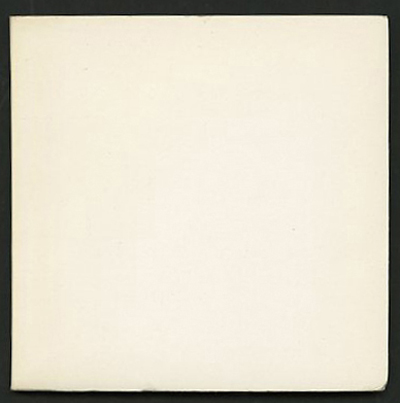GOOD DESIGN
Bruno Munari
Bruno Munari: GOOD DESIGN. Milano: Officine Grafiche Esperia [All Insegna del Pesce d Oro] for Scheiwiller Editore, October 24, 1963. First edition [limited to 2,000 copies]. Text in Italian and English. Square 16mo. Plain white stitched boards. Photo illustrated dust jacket. 31 pp. 6 balck and white illustrations. Jacket lightly worn along spine junctures, but a nearly fine copy in a very good or better dust jacket. Scarce in this condition.
4.85 x 4.85 (120 x 120mm) softcover booklet in dust jacket with 31 pages and 6 balck and white illustrations. Published in an edition of 2,000 copies [Maffei, 2008], Munari’s small book asks “What is good design?” He then answers his query with an orange — “an almost perfect object where shape, function and use display total consistency.”
Good Design was first published in 1963 by Scheiwiller Editore and was then reprinted by Maurizio Corraini and Vanni Scheiwiller together in 1997 to celebrate Bruno Munari’s 90th birthday. "Bruno Munari was among the most inspirational designers of all time, described by Picasso as 'the new Leonardo'. Munari insisted that design be beautiful, functional and accessible." -- Publisher's description of "Bruno Munari: DESIGN AS ART" [Penguin Books, Middlesex, 1966]
Bruno Munari was born in Milan in 1907. At age eighteen, Futurist Filippo Tommaso Marinetti mentored him there. Munari first showcased his "Useless Machines" in 1932 -- a series of Dadaist ever-moving geometrical solids suspended in the air. In 1948, Munari, along with Atanasio Soldati, Gianno Monet and Gillo Dorfles formed the MAC Movement [Movimento Arte Concreta] "to develop abstract painting and sculpture with no links whatsoever to the outside world." During this time, Munari continued creating his Convex-Concave sculptures and experimented with color, space, movement, form and background in his Negative-Positive works. The Italian Design Industry's interest in Munari led him to create the Pigomma Company's toy monkey, the Danese melamine cube ashtray and numerous other industrial design and illustrative works. After a career of over seventy years, Munari gained the title of "founding father of Italian design." Picasso described him as "the new Leonardo."
Munari, a self-taught man, became more than a graphic designer. He was an industrial designer, architect, writer, philosopher and educator. In the 20’s he became involved in the Futurist movement. He worked as a photographer and graphic designer for Pirelli, Cinzano, IBM and Olivetti. After WW2, he started to work as an industrial and interior designer. He challenged all conventions and stereo types, he pulled down barriers between architecture and design with his modest creativity and ingeniousness. Munari created experimental travel sculptures that could collapse and put into a suitcase, simple exquisite lamps, animated children’s books, unreadable books (Libri illegibili), useless machines and so many other beautiful artefacts. He wrote many books, and thanks to Edizione Corraini, many of those have been reprinted. He was awarded the Compasso ‘Oro, Milano in 1954, 1955 and 1979. His advice: “Take life as seriously as a game.”



 Updating...
Updating...